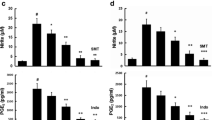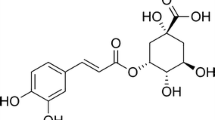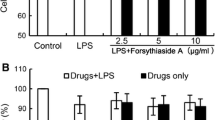Abstract
This study examined whether Salvianolic acid B (Sal B), a major active component of Chinese herb Radix Salviae Miltiorrhizae, may exert an anti-inflammatory effect in microglia and may be neuroprotective by regulating microglial activation. Our results showed that Sal B significantly reduced the production of nitric oxide (NO), tumor necrosis factor-α (TNF-α), interleukin-1β (IL-1β) and reactive oxygen species (ROS) induced by lipopolysaccharide (LPS) treatment in rat primary microglia in a dose-dependent manner. Sal B had no effects on ATP-dependent IL-1β release and interferon (IFN)-γ-induced NO production. Sal B also suppressed LPS-induced inducible nitric oxide synthase (iNOS), TNF-α, and IL-1β mRNA expression, which was accompanied by inhibiting transcription factor NF-κB activation. Sal B could protect neurons through inhibition of microglial activation in a microglia-neuron coculture system. In conclusion, these data demonstrate that anti-inflammatory activity of Sal B in microglia contributes to its neuroprotective effect and suggest that it may be useful for preventing microglia-mediated neuroinflammation.







Similar content being viewed by others
References
Hanisch UK, Kettenmann H (2007) Microglia: active sensor and versatile effector cells in the normal and pathologic brain. Nat Neurosci 10:1387–1394
Rock RB, Gekker G, Hu S et al (2004) Role of microglia in central nervous system infections. Clin Microbiol Rev 17:942–964
Tambuyzer BR, Ponsaerts P, Nouwen EJ (2009) Microglia: gatekeepers of central nervous system immunology. J Leukoc Biol 85:352–370
Kaushal VP, Schlichter LC (2008) Mechanisms of microglia-mediated neurotoxicity in a new model of the stroke. J Neurosci 28:2221–2230
Mabuchi T, Kitagawa K, Ohtsuki T et al (2000) Contribution of microglia/macrophages to expansion of infarction and response of oligodendrocytes after focal cerebral ischemia in rats. Stroke 31:1735–1743
Townsend KP, Pratico D (2005) Novel therapeutic opportunities for Alzheimer’s disease: focus on nonsteroidal anti-inflammatory drugs. FASEB J 19:1592–1601
Zhou L, Zuo Z, Chow MS (2005) Danshen: an overview of its chemistry, pharmacology, pharmacokinetics, and clinical use. J Clin Pharmacol 45:1345–1359
Imanshahidi M, Hosseinzadeh H (2006) The pharmacological effects of Salvia species on the central nervous system. Phytother Re. 20:427–437
Chen YH, Du GH, Zhang JT (2000) Salvianolic acid B protects brain against injuries caused by ischemia-reperfusion in rats. Acta Pharmacol Sin 21:463–466
Tang M, Feng W, Zhang Y et al (2006) Salvianolic acid B improves motor function after cerebral ischemia in rats. Behav Pharmacol 17:493–498
Li M, Zhao C, Wong RN et al (2004) Inhibition of shear-induced platelet aggregation in rat by tetramethylpyrazine and Salvianolic acid B. Clin Hemorheol Microcirc 31:97–103
Tang MK, Ren DC, Zhang JT et al (2002) Effect of Salvianolic acids from Radix Salviae miltiorrhizae on regional cerebral blood flow and platelet aggregation in rats. Phytomedicine 9:405–409
Guo J, Sun K, Wang CS et al (2008) Protective effects of dihydroxylphenyl lactic acid and Salvianolic acid B on LPS-induced mesenteric microcirculatory disturbance in rats. Shock 29:205–211
Chen YL, Hu CS, Lin FY et al (2006) Salvianolic acid B attenuates cyclooxygenase-2 expression in vitro in LPS-treated human aortic smooth muscle cells and in vivo in the apolipoprotein-E-deficient mouse aorta. J Cell Biochem 98:618–631
Lin SJ, Lee IT, Chen YH et al (2007) Salvianolic acid B attenuates MMP-2 and MMP-9 expression in vivo in apolipoprotein-E-deficient mouse aorta and in vitro in LPS-treated human aortic smooth muscle cells. J Cell Biochem 100:372–384
Zhou Z, Liu Y, Miao AD et al (2005) Salvianolic acid B attenuates plasminogen activator inhibitor type 1 production in TNF-alpha treated human umbilical vein endothelial cells. J Cell Biochem 96:109–116
Ding M, Yuan YJ (2007) Study on the mechanisms of an extract of Salvia miltiorrhiza on the regulation of permeability of endothelial cells exposed to tumour necrosis factor-alpha. J Pharm Pharmacol 59:1027–1033
Chen YH, Lin SJ, Ku HH et al (2001) Salvianolic acid B attenuates VCAM-1 and ICAM-1 expression in TNF-alpha-treated human aortic endothelial cells. J Cell Biochem 82:512–521
Luo P, Tan Z, Zhang Z et al (2008) Inhibitory effects of salvianolic acid B on the high glucose-induced mesangial proliferation via NF-kappaB-dependent pathway. Biol Pharm Bull 31(7):1381–1386
Jang S, Kelley KW, Johnson RW (2008) Luteolin reduces IL-6 production in microglia byinhibiting JNK phosphorylation and activation of AP-1. Proc Natl Acad Sci USA 105:7534–7539
Antonelli T, Tomasini M, Fournier J et al (2008) Neurotensin receptor involvement in the rise of extracellular glutamate levels and apoptotic nerve cell death in primary cortical cultures after oxygen and glucose deprivation. Cereb Cortex 18:1748–1757
Sanz JM, Virgilio FD (2000) Kinetics and Mechanism of ATP-Dependent IL-1β Release from Microglial Cells. J Immunol 164:4893–4898
Yang S, Yang J, Yang Z et al (2006) Pituitary adenylate cyclase-activating polypeptide (PACAP) 38 and PACAP4–6 are neuroprotective through inhibition of NADPH oxidase: potent regulators of microglia-mediated oxidative stress. J Pharmacol Exp Ther 319:595–603
Livak KJ, Schmittgen TD (2001) Analysis of relative gene expression data using real-time quantitative PCR and the 2-DDCT method. Methods 25:402–408
Qin L, Liu Y, Wang T et al (2004) NADPH oxidase mediates lipopolysaccharide-induced neurotoxicity and proinflammatory gene expression in activated microglia. J Biol Chem 279:1415–1421
Takenouchi T, Iwamaru Y, Sugama S et al (2008) Lysophospholipids and ATP mutually suppress maturation and release of IL-1β in mouse microglial cells using a Rho-dependent pathway. J Immunol 180:7827–7839
Park JS, Woo MS, Kim DH et al (2007) Anti-inflammatory mechanisms of isoflavone metabolites in lipopolysaccharide-stimulated microglial cells. J Pharmacol Exp Ther 320:1237–1245
Yang S, Zhang D, Yang Z et al (2008) Curcumin protects dopaminergic neuron against LPS induced neurotoxicity in primary rat neuron/glia culture. Neurochem Res 33:2044–2053
Fordyce CB, Jagasia R, Zhu X et al (2005) Microglia Kv1.3 channels contribute to their ability to kill neurons. J. Neurosci 25:7139–7149
Yrjänheikki J, Keinänen R, Pellikka M et al (1998) Tetracyclines inhibit microglial activation and are neuroprotective in global brain ischemia. Proc Natl Acad Sci USA 95:15769–15774
Kim HJ, Rowe M, Ren M et al (2007) Histone deacetylase inhibitors exhibit anti-inflammatory and neuroprotective effects in a rat permanent ischemic model of stroke: multiple mechanisms of action. J Pharmacol Exp Ther 321:892–901
Liu B, Du L, Hong JS (2000) Naloxone protects rat dopaminergic neurons against inflammatory damage through inhibition of microglia activation and superoxide generation. J Pharmacol Exp Ther 293:607–617
Liu Y, Qin L, Li G et al (2003) Dextromethorphan protects dopaminergic neurons against inflammation-mediated degeneration through inhibition of microglial activation. J Pharmacol Exp Ther 305:212–218
Xu Y, Feng D, Wang Y et al (2008) Sodium tanshinone IIA sulfonate protects mice from ConA-induced hepatitis via inhibiting NF-kappaB and IFN-gamma/STAT1 pathways. J Clin Immunol 28:512–519
Jeon SJ, Son KH, Kim YS et al (2008) Inhibition of prostaglandin and nitric oxide production in lipopolysaccharide-treated RAW 264.7 cells by tanshinones from the roots of Salvia miltiorrhiza bunge. Arch. Pharm. Res 31:758–763
Fan GW, Gao XM, Wang H et al (2009) The anti-inflammatory activities of Tanshinone IIA, an active component of TCM, are mediated by estrogen receptor activation and inhibition of iNOS. J Steroid Biochem Mol Biol 113:275–280
Jana M, Jana A, Liu X et al (2007) Involvement of phosphatidylinositol 3-kinase-mediated up-regulation of IκBα in anti-inflammatory effect of Gemfibrozil in microglia. J Immunol 179:4142–4152
Kleinert H, Wallerath T, Fritz G et al (1998) Cytokine induction of NO synthase II in human DLD-1 cells: roles of the JAK-STAT, AP-1 and NF-kappa B-signaling pathways. Br J Pharmacol 125:193–201
Alimonte ID, Flati V, D’Auro M et al (2007) Guanosine inhibits CD40 receptor expression and function induced by cytokines and β amyloid in mouse microglia cells. J Immunol 178:720–731
Zhao GR, Zhang HM, Ye TX et al (2008) Characterization of the radical scavenging and antioxidant activities of danshensu and salvianolic acid B. Food Chem Toxicol 46:73–81
Zhang HS, Wang SQ (2006) Salvianolic acid B from Salvia miltiorrhiza inhibits tumor necrosis factor-α (TNF-α)-induced MMP-2 upregulation in human aortic smooth muscle cells via suppression of NAD(P)H oxidase-derived reactive oxygen species. J Mol Cell Cardiol 41:138–148
Liu CS, Chen NH, Zhang JT (2007) Protection of PC12 cells from hydrogen peroxide-induced cytotoxicity by Salvianolic acid B, a new compound isolated from Radix Salviae miltiorrhizae. Phytomedicine 14:492–497
Lin YH, Liu AH, Wu HL et al (2006) Salvianolic acid B, an antioxidant from Salvia miltiorrhiza, prevents Abeta (25–35)-induced reduction in BPRP in PC12 cells. Biochem Biophys Res Commun 348:593–599
Durairajan SS, Yuan Q, Xie L et al (2008) Salvianolic acid B inhibits Abeta fibril formation and disaggregates preformed fibrils and protects against Abeta-induced cytotoxicty. Neurochem Int 52:741–750
Tang M, Zhang J (2002) Prostate apoptosis response-4 involved in the protective effect of Salvianolic acid B against amyloid β peptide-induced damage in PC12 cells. Jpn J Pharmacol 88:422–427
Acknowledgments
This work is supported by National Natural Science Foundation of China (30572348), the Project of Yunnan Province-Universties Cooperation (2006YX03), National Key Technology R&D Program (2007BAI47B04), University Science & Technology Program of Tianjin (20070314) and National Project 973 (2005CB523400).
Author information
Authors and Affiliations
Corresponding author
Rights and permissions
About this article
Cite this article
Wang, SX., Hu, LM., Gao, XM. et al. Anti-inflammatory Activity of Salvianolic Acid B in Microglia Contributes to its Neuroprotective Effect. Neurochem Res 35, 1029–1037 (2010). https://doi.org/10.1007/s11064-010-0151-1
Received:
Accepted:
Published:
Issue Date:
DOI: https://doi.org/10.1007/s11064-010-0151-1




